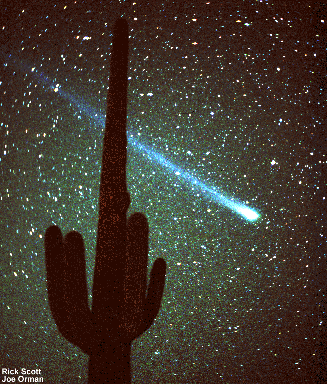Chris wrote:
Ann wrote:
Indeed, the color balance is off here. This is the first time ever that I have seen a dust tail look green. And the ion tail should be bluer.
It does not appear to be off by very much. Do you calibrate your monitor? On my monitors (two, both calibrated) the dust trail appears to be seen in front of the coma, which makes it appear green. You sometimes see this coloration in the dust trail very close to the coma. How blue the ion tail looks is purely a matter of saturation, which is not related to color accuracy. To the eye, the ion tail is very faint blue because of the limits of photopic vision.
To me, there's no doubt whatsoever that the color of this comet is different from all other comets I have seen. It has nothing to do with calibrating my monitor, Chris. I look at existing pictures of different comets and compare their color balance. I don't need to calibrate my monitor for that.
Take a look at the link that Owlice provided to other pictures of this comet. John Chumack has a color picture of Comet McNaught passing NGC 891, and here both tails appear to be the same blue-green color. The blue color of the ion tail is very pale. Steve Yerby has another picture of Comet McNaught passing NGC 891, and here the color of the tails are slightly different, but the ion tail is still a very pale blue color and the dust tail is noticably greenish. Dale Ireland's picture shows the ion tail to be very faintly blue and the dust tail to be green. Rogelio Bernal Andreo's picture shows the ion tail to be a pale greyish blue, and the dust tail to be green. A bright star in the picture looks noticably bluer than the comet's ion tail. In Anthony Ayiomamitis' picture the coma and dust tail are very green, but the ion tail isn't blue at all. Here I think that the color balance of the picture is slightly off. The only picture where the ion tail looks really definitely blue is Andrea Tamanti's, but here the dust tail is still green. And in every single one of the images, the comet coma is very strikingly green.
There can be no doubt about it. This is a green comet. Owlice quoted Sky & Telescope and pointed out that a comet's coma looks green because of gas molecules of cyanogen (CN) and diatomic carbon (C2), whereas the ion tail is blue from ions of carbon monoxide (CO+) and carbon dioxide (CO2+). I'm going to guess that this comet may be particularly rich in gas molecules of cyanogen and diatomic carbon, but that the tail may be rather poor in ions of carbon monoxide and carbon dioxide.
Ann
 Comet McNaught Passes NGC 1245
Comet McNaught Passes NGC 1245

